By Theo Witsell
One of the most exciting things about working as a botanist for the Arkansas Natural Heritage Program is getting to do fieldwork in some of the rarest habitats in the state. Rare habitats very often support rare species, so trips to these kinds of places are like botanical treasure hunts. Across the country, Heritage Program field botanists are regarded as an elite group that make a disproportionate number of important discoveries. Usually, these discoveries represent new occurrences of rare species, or perhaps range extensions, but now and then they represent new species to science. And many of these and other “new” species from Arkansas have been found on state natural areas, which is really no surprise considering that these areas include so many rare habitats.
Below is a list of 22 species that were 1. Found and described by the staff botanists of the ANHC or 2. described new-to-science since the ANHC began in 1973 and also occur on our natural areas. Note that this is not all of the new plant species described from Arkansas, just the ones that our staff were involved in and/or that are known from our natural areas.
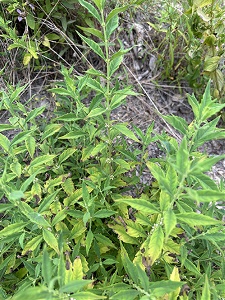 2022: Golden-gland Bugleweed (Lycopus glandulosus) – This rare mint is one of the most recent species to be described from Arkansas. The paper describing it includes records of several collections that I made from state natural areas, including Moro Big Pine and Falcon Bottoms. The crushed foliage has an intense eucalyptus-like scent. The plant occurs in rare open groundwater seepage wetlands in the West Gulf Coastal Plain. Its global range extends into eastern Texas and northwestern Louisiana. You can read more about it here.
2022: Golden-gland Bugleweed (Lycopus glandulosus) – This rare mint is one of the most recent species to be described from Arkansas. The paper describing it includes records of several collections that I made from state natural areas, including Moro Big Pine and Falcon Bottoms. The crushed foliage has an intense eucalyptus-like scent. The plant occurs in rare open groundwater seepage wetlands in the West Gulf Coastal Plain. Its global range extends into eastern Texas and northwestern Louisiana. You can read more about it here.
Photo: Golden-gland Bugleweed (Lycopus glandulosus) by Jim Keesling.
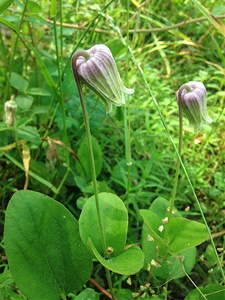 2022: Sandhill Leatherflower (Clematis arenicola) – Two new species of leatherflower, in the genus Clematis, were described in 2022 from Arkansas and both occur on state natural areas. One of these, the Sandhill Leatherflower, is found on several of our natural areas with sandhill woodland or sand barrens habitat in the West Gulf Coastal Plain. I have personally seen and collected it at Miller County Sandhills, Poison Springs and Arkansas Oak natural areas, and it also occurs on the Poison Springs State Forest. Its global range extends into eastern Texas and northwestern Louisiana.
2022: Sandhill Leatherflower (Clematis arenicola) – Two new species of leatherflower, in the genus Clematis, were described in 2022 from Arkansas and both occur on state natural areas. One of these, the Sandhill Leatherflower, is found on several of our natural areas with sandhill woodland or sand barrens habitat in the West Gulf Coastal Plain. I have personally seen and collected it at Miller County Sandhills, Poison Springs and Arkansas Oak natural areas, and it also occurs on the Poison Springs State Forest. Its global range extends into eastern Texas and northwestern Louisiana.
Photo: Sandhill Leatherflower (Clematis arenicola) by Mason Brock.
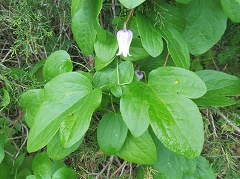 2022: Ouachita Leatherflower (Clematis ouachitensis) – The other newly described leatherflower is the Ouachita Leatherflower which is found along the Cossatot River at the Cossatot River State Park Natural Area and other large streams in the Athens Piedmont Ecoregion of the southern Ouachita Mountains. It is found in rare riverscour grassland habitat, in associated open woodlands and on adjacent river cliffs. Its global range extends into a small part of eastern Oklahoma. There are other undescribed species of leatherflower in Arkansas, which will hopefully be published in the next year or so.
2022: Ouachita Leatherflower (Clematis ouachitensis) – The other newly described leatherflower is the Ouachita Leatherflower which is found along the Cossatot River at the Cossatot River State Park Natural Area and other large streams in the Athens Piedmont Ecoregion of the southern Ouachita Mountains. It is found in rare riverscour grassland habitat, in associated open woodlands and on adjacent river cliffs. Its global range extends into a small part of eastern Oklahoma. There are other undescribed species of leatherflower in Arkansas, which will hopefully be published in the next year or so.
Photo: Ouachita Leatherflower (Clematis ouachitensis) by Mason Brock.
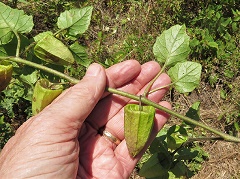 2019: Sandhill Ground-cherry (Physalis macrosperma) – Sometimes a species can go many decades between the time it is first discovered or recognized to be distinct and the time it gets published and becomes official. That was the case with the Sandhill Ground-cherry. This species, a distant relative of the Tomatillo and Chinese Lantern Plant, has especially large fruit when compared to other species in the genus found in Arkansas. It grows in rare sandhill grasslands and was first noticed by former ANHC botanist Steve Orzell and colleagues Milo Pyne and Edwin Bridges in the 1980s. The type locality, or the site from which the species was described, is Miller County Sandhills Natural Area. At that site this species occurs intermixed with both the Sandhill Leatherflower and the Hairy-faced Spiny Pod, discussed below.
2019: Sandhill Ground-cherry (Physalis macrosperma) – Sometimes a species can go many decades between the time it is first discovered or recognized to be distinct and the time it gets published and becomes official. That was the case with the Sandhill Ground-cherry. This species, a distant relative of the Tomatillo and Chinese Lantern Plant, has especially large fruit when compared to other species in the genus found in Arkansas. It grows in rare sandhill grasslands and was first noticed by former ANHC botanist Steve Orzell and colleagues Milo Pyne and Edwin Bridges in the 1980s. The type locality, or the site from which the species was described, is Miller County Sandhills Natural Area. At that site this species occurs intermixed with both the Sandhill Leatherflower and the Hairy-faced Spiny Pod, discussed below.
Photo: Sandhill Ground-cherry (Physalis macrosperma) by Jim Keesling.
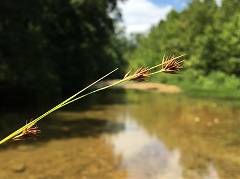 2022: Stiletto Beaksedge (Rhynchospora stiletto) – This rare sedge is known from just seven sites in the world, including sites in Alabama, Arkansas, Missouri and Tennessee. All known population occur in rare types of wet grasslands over limestone or dolomite bedrock. The Arkansas populations are found in fens (high-pH wet meadows fed by groundwater) over dolomite bedrock at Rock Creek Natural Area in Sharp County.
2022: Stiletto Beaksedge (Rhynchospora stiletto) – This rare sedge is known from just seven sites in the world, including sites in Alabama, Arkansas, Missouri and Tennessee. All known population occur in rare types of wet grasslands over limestone or dolomite bedrock. The Arkansas populations are found in fens (high-pH wet meadows fed by groundwater) over dolomite bedrock at Rock Creek Natural Area in Sharp County.
Photo: Stiletto Beaksedge (Rhynchospora stiletto) by Theo Witsell.
 2016: Hairy-faced Spiny Pod (Matelea hirtelliflora) – This rare climbing milkweed was described from sandhill habitat in east Texas and later discovered in Arkansas when photos of flowering specimens taken at Miller County Sandhills Natural Area were posted to iNaturalist. It had been collected from that site in the past, but specimens were identified as the common, and superficially similar, Purple Climbing-milkweed (Matelea decipiens).
2016: Hairy-faced Spiny Pod (Matelea hirtelliflora) – This rare climbing milkweed was described from sandhill habitat in east Texas and later discovered in Arkansas when photos of flowering specimens taken at Miller County Sandhills Natural Area were posted to iNaturalist. It had been collected from that site in the past, but specimens were identified as the common, and superficially similar, Purple Climbing-milkweed (Matelea decipiens).
Photo: Hairy-faced Spiny Pod (Matelea hirtelliflora) by Jim Keesling.
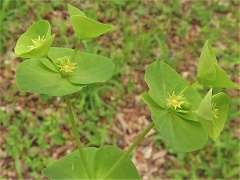 2013: Ouachita Spurge (Euphorbia ouachitana) – This species is found on cliffs and in glades and rocky, open woodlands in the Ouachita Mountains of Arkansas and Oklahoma, with a few small outlying populations in southern Missouri and central Tennessee. Populations have been found at the Cossatot River State Park-Natural Area.
2013: Ouachita Spurge (Euphorbia ouachitana) – This species is found on cliffs and in glades and rocky, open woodlands in the Ouachita Mountains of Arkansas and Oklahoma, with a few small outlying populations in southern Missouri and central Tennessee. Populations have been found at the Cossatot River State Park-Natural Area.
Photo: Ouachita Spurge (Euphorbia ouachitana) by Jim Keesling.
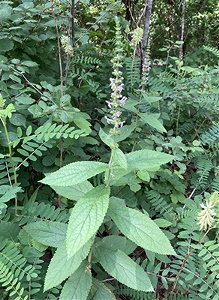 2008: Ouachita Hedge-nettle (Stachys iltisii) – This rare mint has a narrow global range in the Interior Highlands (the Arkansas Valley, Ouachita Mountains and Ozark Plateaus) of Arkansas, Missouri and Oklahoma, where it is found in forests and woodlands with moderate moisture. Populations are known from Alum Fork Natural Area and Cossatot River State Park-Natural Area.
2008: Ouachita Hedge-nettle (Stachys iltisii) – This rare mint has a narrow global range in the Interior Highlands (the Arkansas Valley, Ouachita Mountains and Ozark Plateaus) of Arkansas, Missouri and Oklahoma, where it is found in forests and woodlands with moderate moisture. Populations are known from Alum Fork Natural Area and Cossatot River State Park-Natural Area.
Photo: Ouachita Hedge-nettle (Stachys iltisii) by Theo Witsell.
 2006/2013: Arkansas Spring Beauty (Claytonia arkansana) – This globally rare species has a complicated history. It was originally described in 2006 as Claytonia ozarkensis and attributed to sites in Arkansas, Missouri and Oklahoma, but it turns out that several of the specimens cited in the paper were misidentified. This included the specimens from Missouri and Oklahoma as well as the type specimen, from Washington County, overestimating the geographic range. Also, because the type specimen was misidentified, the scientific name was invalid. A second paper was published in 2013 to clarify the identifying characters, range, and give it a new name, Claytonia arkansana, chosen to highlight the narrow range – known from just 10 populations in three Arkansas counties! You can read more in the 2013 paper here.The species grows only on sandstone cliffs in Cleburne, Faulkner and Van Buren counties. One of the 10 populations occurs on cliffs at Cove Creek Natural Area.
2006/2013: Arkansas Spring Beauty (Claytonia arkansana) – This globally rare species has a complicated history. It was originally described in 2006 as Claytonia ozarkensis and attributed to sites in Arkansas, Missouri and Oklahoma, but it turns out that several of the specimens cited in the paper were misidentified. This included the specimens from Missouri and Oklahoma as well as the type specimen, from Washington County, overestimating the geographic range. Also, because the type specimen was misidentified, the scientific name was invalid. A second paper was published in 2013 to clarify the identifying characters, range, and give it a new name, Claytonia arkansana, chosen to highlight the narrow range – known from just 10 populations in three Arkansas counties! You can read more in the 2013 paper here.The species grows only on sandstone cliffs in Cleburne, Faulkner and Van Buren counties. One of the 10 populations occurs on cliffs at Cove Creek Natural Area.
Photo: Arkansas Spring Beauty (Claytonia arkansana) by Leslie Patrick.
 2006: Church’s Wild Rye (Elymus churchii) – This beautiful grass is found only in the Interior Highlands (the Arkansas Valley, Ouachita Mountains, and Ozark Plateaus) of Arkansas, Missouri and Oklahoma. It is associated with cliffs, glade margins and rocky, open woodlands. Several small populations have been found at Devil’s Eyebrow Natural Area.
2006: Church’s Wild Rye (Elymus churchii) – This beautiful grass is found only in the Interior Highlands (the Arkansas Valley, Ouachita Mountains, and Ozark Plateaus) of Arkansas, Missouri and Oklahoma. It is associated with cliffs, glade margins and rocky, open woodlands. Several small populations have been found at Devil’s Eyebrow Natural Area.
Photo: Church's Wild Rye (Elymus churchii) by Theo Witsell.
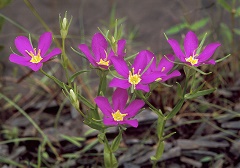 2005: Pelton‘s Rose-gentian (Sabatia arkansana) – This species is found only in Saline County, where it is known from two types of rare glade habitats near Bauxite and Owensville, and nowhere else on Earth. I described it, along with Dr. Jim Pringle at the Royal Botanical Gardens in Canada, and named it in honor of the late John Pelton, a retired mechanic and nature photographer who was a friend and mentor of mine and first showed me the plants. One of the largest populations known is at Middle Fork Barrens Natural Area. As with the other species listed, it grows in very rare habitats; in this case seasonally wet glades on shale and nepheline syenite (a rare type of igneous rock).
2005: Pelton‘s Rose-gentian (Sabatia arkansana) – This species is found only in Saline County, where it is known from two types of rare glade habitats near Bauxite and Owensville, and nowhere else on Earth. I described it, along with Dr. Jim Pringle at the Royal Botanical Gardens in Canada, and named it in honor of the late John Pelton, a retired mechanic and nature photographer who was a friend and mentor of mine and first showed me the plants. One of the largest populations known is at Middle Fork Barrens Natural Area. As with the other species listed, it grows in very rare habitats; in this case seasonally wet glades on shale and nepheline syenite (a rare type of igneous rock).
Photo: Pelton's Rose-gentian (Sabatia arkansana) by John Pelton.
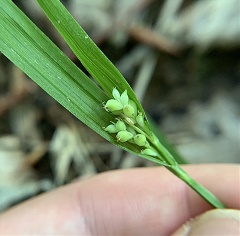 2002: Kral’s Sedge (Carex kraliana) – Carex is the most diverse genus of plants in the state, with nearly 140 species documented to date, and new ones found every few years. Kral’s Sedge, named for Dr. Robert Kral, who himself described several of the new species featured here, is found in Arkansas in rich, moist forested ravines in the West Gulf Coastal Plain and on Crowley’s Ridge. Populations are known from Nacatoch Ravines Natural Area and Wittsburg Natural Area.
2002: Kral’s Sedge (Carex kraliana) – Carex is the most diverse genus of plants in the state, with nearly 140 species documented to date, and new ones found every few years. Kral’s Sedge, named for Dr. Robert Kral, who himself described several of the new species featured here, is found in Arkansas in rich, moist forested ravines in the West Gulf Coastal Plain and on Crowley’s Ridge. Populations are known from Nacatoch Ravines Natural Area and Wittsburg Natural Area.
Photo: Kral's Sedge (Carex kraliana) by Brendan Kosnik.
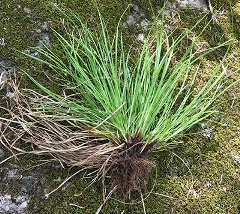 2001: Timid Sedge (Carex timida) – Another species of sedge described in recent decades and rare in Arkansas, this species is found in two areas of the state: several counties in the western Ouachita Mountains, and several counties in the central Ozarks. Its global range is somewhat narrow and scattered, centered on the lower Midwest and Interior Highlands. Populations are known at Cossatot River State Park-Natural Area and Rock Creek Natural Area.
2001: Timid Sedge (Carex timida) – Another species of sedge described in recent decades and rare in Arkansas, this species is found in two areas of the state: several counties in the western Ouachita Mountains, and several counties in the central Ozarks. Its global range is somewhat narrow and scattered, centered on the lower Midwest and Interior Highlands. Populations are known at Cossatot River State Park-Natural Area and Rock Creek Natural Area.
Photo: Timid Sedge (Carex timida) by Theo Witsell.
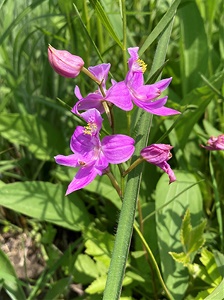 1994: Oklahoma Grass-pink (Calopogon oklahomensis) – This rare and beautiful orchid is found only in the highest quality ancient prairie remnants. Populations are known from Cherokee Prairie, Chesney Prairie, Downs Prairie, H.E. Flanagan Prairie, Konecny Prairie, Railroad Prairie, Roth Prairie, and Searles Prairie natural areas.
1994: Oklahoma Grass-pink (Calopogon oklahomensis) – This rare and beautiful orchid is found only in the highest quality ancient prairie remnants. Populations are known from Cherokee Prairie, Chesney Prairie, Downs Prairie, H.E. Flanagan Prairie, Konecny Prairie, Railroad Prairie, Roth Prairie, and Searles Prairie natural areas.
Photo: Oklahoma Grass-pink (Calopogon oklahomensis) by Theo Witsell.
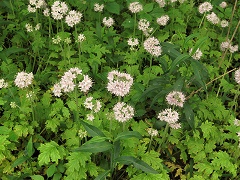 1992: Browne’s Waterleaf (Hydrophyllum brownei) – This species is found only in mesic forests in the Ouachita Mountains. A funny story about this species … it was actually first collected in 1835 by physician and botanist George Englemann along the North Fork of the Saline River near Benton, as he was traveling from Little Rock to Hot Springs. However, he was guilty of collecting a “top snatch,” or an incomplete specimen, where the underground portions of the plant are not collected. As it turns out the most distinct and easy-to-see feature that makes Browne’s Waterleaf distinct from a more common eastern species (Hydrophyllum macrophyllum) is the presence of small potato-like tubers on the roots. Englemann’s specimen lacks these features because it only includes the above ground portions of the plant. Because of this corner-cutting by Engelmann, his specimen sat in the herbarium misidentified as the common eastern species for 157 years until Browne’s Waterleaf was described. Populations are known from two state natural areas: Cossatot River State Park-Natural Area and Big Fork Creek Natural Area.
1992: Browne’s Waterleaf (Hydrophyllum brownei) – This species is found only in mesic forests in the Ouachita Mountains. A funny story about this species … it was actually first collected in 1835 by physician and botanist George Englemann along the North Fork of the Saline River near Benton, as he was traveling from Little Rock to Hot Springs. However, he was guilty of collecting a “top snatch,” or an incomplete specimen, where the underground portions of the plant are not collected. As it turns out the most distinct and easy-to-see feature that makes Browne’s Waterleaf distinct from a more common eastern species (Hydrophyllum macrophyllum) is the presence of small potato-like tubers on the roots. Englemann’s specimen lacks these features because it only includes the above ground portions of the plant. Because of this corner-cutting by Engelmann, his specimen sat in the herbarium misidentified as the common eastern species for 157 years until Browne’s Waterleaf was described. Populations are known from two state natural areas: Cossatot River State Park-Natural Area and Big Fork Creek Natural Area.
Photo: Browne's Waterleaf (Hydrophyllum brownei) by Jim Keesling.
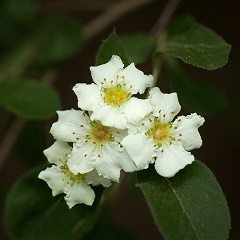 1990: Stern’s Medlar (Crataegus × canescens, aka Mespilus canescens) – Known as “Arkansas’ rarest shrub,” Stern’s medlar is known from just 24 individuals at a single site in the world, a rare “prairie slash” woodland at Konecny Grove Natural Area. It was first collected by naturalist Jane Stern in 1969 but wasn’t described until 1990. Despite surveys at many additional sites across the region, no other populations have been found. You can read more about Arkansas’ rarest shrub here.
1990: Stern’s Medlar (Crataegus × canescens, aka Mespilus canescens) – Known as “Arkansas’ rarest shrub,” Stern’s medlar is known from just 24 individuals at a single site in the world, a rare “prairie slash” woodland at Konecny Grove Natural Area. It was first collected by naturalist Jane Stern in 1969 but wasn’t described until 1990. Despite surveys at many additional sites across the region, no other populations have been found. You can read more about Arkansas’ rarest shrub here.
Photo: Stern's Medlar (Crataegus x canescens, aka Mespilus canescens) by John Moore.
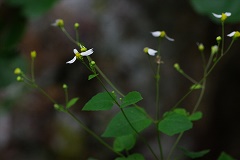 1989: Cossatot Leafcup (Polymnia cossatotensis) – This species was described in 1989, but for the Cossatot Mountains, not the Cossatot River. It was described by former ANHC botanist Bert Pittman and colleagues Vernon Bates and Robert Kral. It is presently known from just five sites in the world, all in a small area of the Ouachita Mountains where it grows in specialized habitats – novaculite talus slopes (steep slopes of loose chunks of rock and little soil) and glade margins. One remarkable thing about this species is its large size (up to 7 feet tall) and conspicuous, large heart-shaped leaves. If you were to come across a patch you might wonder how a species like this could have been overlooked until 1989. The answer, of course, is because it is so rare and grows in such inaccessible terrain. Another remarkable thing about it is that it can grow in almost no soil. It is perfectly at home in loose rubble at the base of steep slopes and cliffs where the roots just wrap around the rocks and work their way down into crevices to get some organic matter.
1989: Cossatot Leafcup (Polymnia cossatotensis) – This species was described in 1989, but for the Cossatot Mountains, not the Cossatot River. It was described by former ANHC botanist Bert Pittman and colleagues Vernon Bates and Robert Kral. It is presently known from just five sites in the world, all in a small area of the Ouachita Mountains where it grows in specialized habitats – novaculite talus slopes (steep slopes of loose chunks of rock and little soil) and glade margins. One remarkable thing about this species is its large size (up to 7 feet tall) and conspicuous, large heart-shaped leaves. If you were to come across a patch you might wonder how a species like this could have been overlooked until 1989. The answer, of course, is because it is so rare and grows in such inaccessible terrain. Another remarkable thing about it is that it can grow in almost no soil. It is perfectly at home in loose rubble at the base of steep slopes and cliffs where the roots just wrap around the rocks and work their way down into crevices to get some organic matter.
Photo: Cossatot Leafcup (Polymnia cossatotensis) by Paul Bernard.
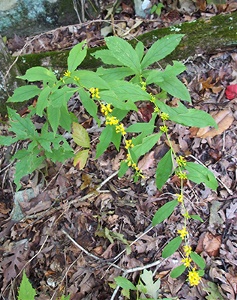 1986: Ouachita Goldenrod (Solidago ouachitensis) – There are more than 30 different goldenrod species known from Arkansas and this forest-dwelling species has the narrowest range of all of them, found only in the central and western parts of the Ouachita Mountains and on the tops of Mount Magazine and Mount Nebo in the Arkansas Valley. A population is known at Big Fork Creek Natural Area.
1986: Ouachita Goldenrod (Solidago ouachitensis) – There are more than 30 different goldenrod species known from Arkansas and this forest-dwelling species has the narrowest range of all of them, found only in the central and western parts of the Ouachita Mountains and on the tops of Mount Magazine and Mount Nebo in the Arkansas Valley. A population is known at Big Fork Creek Natural Area.
Photo: Ouachita Goldenrod (Solidago ouachitensis) by Brent Baker.
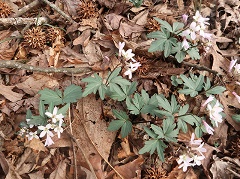 1982: Ouachita Toothwort (Cardamine angustata var. ouachitana) – This toothwort is known from just eight counties in the world, all in the southern Ouachita Mountains of Arkansas and Oklahoma. While originally described as a variety of a common species found east of the Mississippi River, ongoing research suggests that it is not closely related to that species, and it will be elevated to species-level status based on several lines of evidence. Populations are known from Big Fork Creek Natural Area, Cossatot River State Park-Natural Area, Fernwood Seep Natural Area and Iron Mountain Natural Area.
1982: Ouachita Toothwort (Cardamine angustata var. ouachitana) – This toothwort is known from just eight counties in the world, all in the southern Ouachita Mountains of Arkansas and Oklahoma. While originally described as a variety of a common species found east of the Mississippi River, ongoing research suggests that it is not closely related to that species, and it will be elevated to species-level status based on several lines of evidence. Populations are known from Big Fork Creek Natural Area, Cossatot River State Park-Natural Area, Fernwood Seep Natural Area and Iron Mountain Natural Area.
Photo: Ouachita Toothwort (Cardamine angustata var. ouachitana) by Jim Keesling.
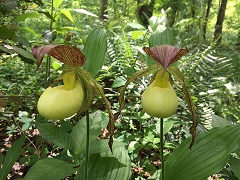 1981: Kentucky Lady’s-slipper (Cypripedium kentuckiense) – Considered by many to be one of our most beautiful wildflowers, it is remarkable that this species was not formally recognized until 1981. It is considered a species of conservation concern in each of the 10 states within its range, though Arkansas has more populations than any other state, with most known in the Ouachita Mountains. Populations are known from five of our natural areas, four in the Ouachita Mountains and one in the West Gulf Coastal Plain.
1981: Kentucky Lady’s-slipper (Cypripedium kentuckiense) – Considered by many to be one of our most beautiful wildflowers, it is remarkable that this species was not formally recognized until 1981. It is considered a species of conservation concern in each of the 10 states within its range, though Arkansas has more populations than any other state, with most known in the Ouachita Mountains. Populations are known from five of our natural areas, four in the Ouachita Mountains and one in the West Gulf Coastal Plain.
Photo: Kentucky Lady's-slipper (Cypripedium kentuckiense) by Theo Witsell.
 1979: Hairy-flower Arkansas Bedstraw (Galium arkansanum var. pubiflorum) – Even at the species level, Arkansas Bedstraw has a limited range, almost entirely restricted to the Interior Highlands, though the typical variety (var. arkansanum) is common. Variety pubiflorum, however, is very rare and is restricted to the central portion of the Ouachitas where it is generally found in areas of novaculite geology and higher elevations. A small population is known from Gap Creek Natural Area.
1979: Hairy-flower Arkansas Bedstraw (Galium arkansanum var. pubiflorum) – Even at the species level, Arkansas Bedstraw has a limited range, almost entirely restricted to the Interior Highlands, though the typical variety (var. arkansanum) is common. Variety pubiflorum, however, is very rare and is restricted to the central portion of the Ouachitas where it is generally found in areas of novaculite geology and higher elevations. A small population is known from Gap Creek Natural Area.
Photo: Herbarium specimen of Hairy-flower Arkansas Bedstraw (Galium arkansanum var. pubiflorum), UARK Herbarium.
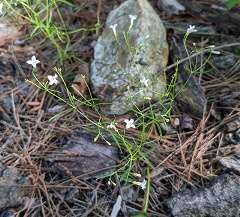 1976: Ouachita Bluet (Houstonia ouachitana) – One of several plants found only in the Ouachita Mountains, this species is found on cliffs and in rocky, open woodlands. It is known from the Cossatot River State Park-Natural Area and Gap Creek Natural Area.
1976: Ouachita Bluet (Houstonia ouachitana) – One of several plants found only in the Ouachita Mountains, this species is found on cliffs and in rocky, open woodlands. It is known from the Cossatot River State Park-Natural Area and Gap Creek Natural Area.
Photo: Ouachita Bluet (Houstonia ouachitana) by Joseph Aubert.
In addition to the species listed above, we are aware of several other undescribed species of plants that are found in Arkansas and some of them on state natural areas. The challenge is finding the time to do the tedious research and documentation needed to get them described and published. Watch future ANHC e-newsletters for any updates.
One of the most exciting things about working as a botanist for the Arkansas Natural Heritage Program is getting to do fieldwork in some of the rarest habitats in the state. Rare habitats very often support rare species, so trips to these kinds of places are like botanical treasure hunts. Across the country, Heritage Program field botanists are regarded as an elite group that make a disproportionate number of important discoveries. Usually, these discoveries represent new occurrences of rare species, or perhaps range extensions, but now and then they represent new species to science. And many of these and other “new” species from Arkansas have been found on state natural areas, which is really no surprise considering that these areas include so many rare habitats.
Below is a list of 22 species that were 1. Found and described by the staff botanists of the ANHC or 2. described new-to-science since the ANHC began in 1973 and also occur on our natural areas. Note that this is not all of the new plant species described from Arkansas, just the ones that our staff were involved in and/or that are known from our natural areas.
 2022: Golden-gland Bugleweed (Lycopus glandulosus) – This rare mint is one of the most recent species to be described from Arkansas. The paper describing it includes records of several collections that I made from state natural areas, including Moro Big Pine and Falcon Bottoms. The crushed foliage has an intense eucalyptus-like scent. The plant occurs in rare open groundwater seepage wetlands in the West Gulf Coastal Plain. Its global range extends into eastern Texas and northwestern Louisiana. You can read more about it here.
2022: Golden-gland Bugleweed (Lycopus glandulosus) – This rare mint is one of the most recent species to be described from Arkansas. The paper describing it includes records of several collections that I made from state natural areas, including Moro Big Pine and Falcon Bottoms. The crushed foliage has an intense eucalyptus-like scent. The plant occurs in rare open groundwater seepage wetlands in the West Gulf Coastal Plain. Its global range extends into eastern Texas and northwestern Louisiana. You can read more about it here. Photo: Golden-gland Bugleweed (Lycopus glandulosus) by Jim Keesling.
 2022: Sandhill Leatherflower (Clematis arenicola) – Two new species of leatherflower, in the genus Clematis, were described in 2022 from Arkansas and both occur on state natural areas. One of these, the Sandhill Leatherflower, is found on several of our natural areas with sandhill woodland or sand barrens habitat in the West Gulf Coastal Plain. I have personally seen and collected it at Miller County Sandhills, Poison Springs and Arkansas Oak natural areas, and it also occurs on the Poison Springs State Forest. Its global range extends into eastern Texas and northwestern Louisiana.
2022: Sandhill Leatherflower (Clematis arenicola) – Two new species of leatherflower, in the genus Clematis, were described in 2022 from Arkansas and both occur on state natural areas. One of these, the Sandhill Leatherflower, is found on several of our natural areas with sandhill woodland or sand barrens habitat in the West Gulf Coastal Plain. I have personally seen and collected it at Miller County Sandhills, Poison Springs and Arkansas Oak natural areas, and it also occurs on the Poison Springs State Forest. Its global range extends into eastern Texas and northwestern Louisiana.Photo: Sandhill Leatherflower (Clematis arenicola) by Mason Brock.
 2022: Ouachita Leatherflower (Clematis ouachitensis) – The other newly described leatherflower is the Ouachita Leatherflower which is found along the Cossatot River at the Cossatot River State Park Natural Area and other large streams in the Athens Piedmont Ecoregion of the southern Ouachita Mountains. It is found in rare riverscour grassland habitat, in associated open woodlands and on adjacent river cliffs. Its global range extends into a small part of eastern Oklahoma. There are other undescribed species of leatherflower in Arkansas, which will hopefully be published in the next year or so.
2022: Ouachita Leatherflower (Clematis ouachitensis) – The other newly described leatherflower is the Ouachita Leatherflower which is found along the Cossatot River at the Cossatot River State Park Natural Area and other large streams in the Athens Piedmont Ecoregion of the southern Ouachita Mountains. It is found in rare riverscour grassland habitat, in associated open woodlands and on adjacent river cliffs. Its global range extends into a small part of eastern Oklahoma. There are other undescribed species of leatherflower in Arkansas, which will hopefully be published in the next year or so.Photo: Ouachita Leatherflower (Clematis ouachitensis) by Mason Brock.
 2019: Sandhill Ground-cherry (Physalis macrosperma) – Sometimes a species can go many decades between the time it is first discovered or recognized to be distinct and the time it gets published and becomes official. That was the case with the Sandhill Ground-cherry. This species, a distant relative of the Tomatillo and Chinese Lantern Plant, has especially large fruit when compared to other species in the genus found in Arkansas. It grows in rare sandhill grasslands and was first noticed by former ANHC botanist Steve Orzell and colleagues Milo Pyne and Edwin Bridges in the 1980s. The type locality, or the site from which the species was described, is Miller County Sandhills Natural Area. At that site this species occurs intermixed with both the Sandhill Leatherflower and the Hairy-faced Spiny Pod, discussed below.
2019: Sandhill Ground-cherry (Physalis macrosperma) – Sometimes a species can go many decades between the time it is first discovered or recognized to be distinct and the time it gets published and becomes official. That was the case with the Sandhill Ground-cherry. This species, a distant relative of the Tomatillo and Chinese Lantern Plant, has especially large fruit when compared to other species in the genus found in Arkansas. It grows in rare sandhill grasslands and was first noticed by former ANHC botanist Steve Orzell and colleagues Milo Pyne and Edwin Bridges in the 1980s. The type locality, or the site from which the species was described, is Miller County Sandhills Natural Area. At that site this species occurs intermixed with both the Sandhill Leatherflower and the Hairy-faced Spiny Pod, discussed below.Photo: Sandhill Ground-cherry (Physalis macrosperma) by Jim Keesling.
 2022: Stiletto Beaksedge (Rhynchospora stiletto) – This rare sedge is known from just seven sites in the world, including sites in Alabama, Arkansas, Missouri and Tennessee. All known population occur in rare types of wet grasslands over limestone or dolomite bedrock. The Arkansas populations are found in fens (high-pH wet meadows fed by groundwater) over dolomite bedrock at Rock Creek Natural Area in Sharp County.
2022: Stiletto Beaksedge (Rhynchospora stiletto) – This rare sedge is known from just seven sites in the world, including sites in Alabama, Arkansas, Missouri and Tennessee. All known population occur in rare types of wet grasslands over limestone or dolomite bedrock. The Arkansas populations are found in fens (high-pH wet meadows fed by groundwater) over dolomite bedrock at Rock Creek Natural Area in Sharp County.Photo: Stiletto Beaksedge (Rhynchospora stiletto) by Theo Witsell.
 2016: Hairy-faced Spiny Pod (Matelea hirtelliflora) – This rare climbing milkweed was described from sandhill habitat in east Texas and later discovered in Arkansas when photos of flowering specimens taken at Miller County Sandhills Natural Area were posted to iNaturalist. It had been collected from that site in the past, but specimens were identified as the common, and superficially similar, Purple Climbing-milkweed (Matelea decipiens).
2016: Hairy-faced Spiny Pod (Matelea hirtelliflora) – This rare climbing milkweed was described from sandhill habitat in east Texas and later discovered in Arkansas when photos of flowering specimens taken at Miller County Sandhills Natural Area were posted to iNaturalist. It had been collected from that site in the past, but specimens were identified as the common, and superficially similar, Purple Climbing-milkweed (Matelea decipiens). Photo: Hairy-faced Spiny Pod (Matelea hirtelliflora) by Jim Keesling.
 2013: Ouachita Spurge (Euphorbia ouachitana) – This species is found on cliffs and in glades and rocky, open woodlands in the Ouachita Mountains of Arkansas and Oklahoma, with a few small outlying populations in southern Missouri and central Tennessee. Populations have been found at the Cossatot River State Park-Natural Area.
2013: Ouachita Spurge (Euphorbia ouachitana) – This species is found on cliffs and in glades and rocky, open woodlands in the Ouachita Mountains of Arkansas and Oklahoma, with a few small outlying populations in southern Missouri and central Tennessee. Populations have been found at the Cossatot River State Park-Natural Area.Photo: Ouachita Spurge (Euphorbia ouachitana) by Jim Keesling.
 2008: Ouachita Hedge-nettle (Stachys iltisii) – This rare mint has a narrow global range in the Interior Highlands (the Arkansas Valley, Ouachita Mountains and Ozark Plateaus) of Arkansas, Missouri and Oklahoma, where it is found in forests and woodlands with moderate moisture. Populations are known from Alum Fork Natural Area and Cossatot River State Park-Natural Area.
2008: Ouachita Hedge-nettle (Stachys iltisii) – This rare mint has a narrow global range in the Interior Highlands (the Arkansas Valley, Ouachita Mountains and Ozark Plateaus) of Arkansas, Missouri and Oklahoma, where it is found in forests and woodlands with moderate moisture. Populations are known from Alum Fork Natural Area and Cossatot River State Park-Natural Area.Photo: Ouachita Hedge-nettle (Stachys iltisii) by Theo Witsell.
 2006/2013: Arkansas Spring Beauty (Claytonia arkansana) – This globally rare species has a complicated history. It was originally described in 2006 as Claytonia ozarkensis and attributed to sites in Arkansas, Missouri and Oklahoma, but it turns out that several of the specimens cited in the paper were misidentified. This included the specimens from Missouri and Oklahoma as well as the type specimen, from Washington County, overestimating the geographic range. Also, because the type specimen was misidentified, the scientific name was invalid. A second paper was published in 2013 to clarify the identifying characters, range, and give it a new name, Claytonia arkansana, chosen to highlight the narrow range – known from just 10 populations in three Arkansas counties! You can read more in the 2013 paper here.The species grows only on sandstone cliffs in Cleburne, Faulkner and Van Buren counties. One of the 10 populations occurs on cliffs at Cove Creek Natural Area.
2006/2013: Arkansas Spring Beauty (Claytonia arkansana) – This globally rare species has a complicated history. It was originally described in 2006 as Claytonia ozarkensis and attributed to sites in Arkansas, Missouri and Oklahoma, but it turns out that several of the specimens cited in the paper were misidentified. This included the specimens from Missouri and Oklahoma as well as the type specimen, from Washington County, overestimating the geographic range. Also, because the type specimen was misidentified, the scientific name was invalid. A second paper was published in 2013 to clarify the identifying characters, range, and give it a new name, Claytonia arkansana, chosen to highlight the narrow range – known from just 10 populations in three Arkansas counties! You can read more in the 2013 paper here.The species grows only on sandstone cliffs in Cleburne, Faulkner and Van Buren counties. One of the 10 populations occurs on cliffs at Cove Creek Natural Area.Photo: Arkansas Spring Beauty (Claytonia arkansana) by Leslie Patrick.
 2006: Church’s Wild Rye (Elymus churchii) – This beautiful grass is found only in the Interior Highlands (the Arkansas Valley, Ouachita Mountains, and Ozark Plateaus) of Arkansas, Missouri and Oklahoma. It is associated with cliffs, glade margins and rocky, open woodlands. Several small populations have been found at Devil’s Eyebrow Natural Area.
2006: Church’s Wild Rye (Elymus churchii) – This beautiful grass is found only in the Interior Highlands (the Arkansas Valley, Ouachita Mountains, and Ozark Plateaus) of Arkansas, Missouri and Oklahoma. It is associated with cliffs, glade margins and rocky, open woodlands. Several small populations have been found at Devil’s Eyebrow Natural Area.Photo: Church's Wild Rye (Elymus churchii) by Theo Witsell.
 2005: Pelton‘s Rose-gentian (Sabatia arkansana) – This species is found only in Saline County, where it is known from two types of rare glade habitats near Bauxite and Owensville, and nowhere else on Earth. I described it, along with Dr. Jim Pringle at the Royal Botanical Gardens in Canada, and named it in honor of the late John Pelton, a retired mechanic and nature photographer who was a friend and mentor of mine and first showed me the plants. One of the largest populations known is at Middle Fork Barrens Natural Area. As with the other species listed, it grows in very rare habitats; in this case seasonally wet glades on shale and nepheline syenite (a rare type of igneous rock).
2005: Pelton‘s Rose-gentian (Sabatia arkansana) – This species is found only in Saline County, where it is known from two types of rare glade habitats near Bauxite and Owensville, and nowhere else on Earth. I described it, along with Dr. Jim Pringle at the Royal Botanical Gardens in Canada, and named it in honor of the late John Pelton, a retired mechanic and nature photographer who was a friend and mentor of mine and first showed me the plants. One of the largest populations known is at Middle Fork Barrens Natural Area. As with the other species listed, it grows in very rare habitats; in this case seasonally wet glades on shale and nepheline syenite (a rare type of igneous rock). Photo: Pelton's Rose-gentian (Sabatia arkansana) by John Pelton.
 2002: Kral’s Sedge (Carex kraliana) – Carex is the most diverse genus of plants in the state, with nearly 140 species documented to date, and new ones found every few years. Kral’s Sedge, named for Dr. Robert Kral, who himself described several of the new species featured here, is found in Arkansas in rich, moist forested ravines in the West Gulf Coastal Plain and on Crowley’s Ridge. Populations are known from Nacatoch Ravines Natural Area and Wittsburg Natural Area.
2002: Kral’s Sedge (Carex kraliana) – Carex is the most diverse genus of plants in the state, with nearly 140 species documented to date, and new ones found every few years. Kral’s Sedge, named for Dr. Robert Kral, who himself described several of the new species featured here, is found in Arkansas in rich, moist forested ravines in the West Gulf Coastal Plain and on Crowley’s Ridge. Populations are known from Nacatoch Ravines Natural Area and Wittsburg Natural Area.Photo: Kral's Sedge (Carex kraliana) by Brendan Kosnik.
 2001: Timid Sedge (Carex timida) – Another species of sedge described in recent decades and rare in Arkansas, this species is found in two areas of the state: several counties in the western Ouachita Mountains, and several counties in the central Ozarks. Its global range is somewhat narrow and scattered, centered on the lower Midwest and Interior Highlands. Populations are known at Cossatot River State Park-Natural Area and Rock Creek Natural Area.
2001: Timid Sedge (Carex timida) – Another species of sedge described in recent decades and rare in Arkansas, this species is found in two areas of the state: several counties in the western Ouachita Mountains, and several counties in the central Ozarks. Its global range is somewhat narrow and scattered, centered on the lower Midwest and Interior Highlands. Populations are known at Cossatot River State Park-Natural Area and Rock Creek Natural Area.Photo: Timid Sedge (Carex timida) by Theo Witsell.
 1994: Oklahoma Grass-pink (Calopogon oklahomensis) – This rare and beautiful orchid is found only in the highest quality ancient prairie remnants. Populations are known from Cherokee Prairie, Chesney Prairie, Downs Prairie, H.E. Flanagan Prairie, Konecny Prairie, Railroad Prairie, Roth Prairie, and Searles Prairie natural areas.
1994: Oklahoma Grass-pink (Calopogon oklahomensis) – This rare and beautiful orchid is found only in the highest quality ancient prairie remnants. Populations are known from Cherokee Prairie, Chesney Prairie, Downs Prairie, H.E. Flanagan Prairie, Konecny Prairie, Railroad Prairie, Roth Prairie, and Searles Prairie natural areas. Photo: Oklahoma Grass-pink (Calopogon oklahomensis) by Theo Witsell.
 1992: Browne’s Waterleaf (Hydrophyllum brownei) – This species is found only in mesic forests in the Ouachita Mountains. A funny story about this species … it was actually first collected in 1835 by physician and botanist George Englemann along the North Fork of the Saline River near Benton, as he was traveling from Little Rock to Hot Springs. However, he was guilty of collecting a “top snatch,” or an incomplete specimen, where the underground portions of the plant are not collected. As it turns out the most distinct and easy-to-see feature that makes Browne’s Waterleaf distinct from a more common eastern species (Hydrophyllum macrophyllum) is the presence of small potato-like tubers on the roots. Englemann’s specimen lacks these features because it only includes the above ground portions of the plant. Because of this corner-cutting by Engelmann, his specimen sat in the herbarium misidentified as the common eastern species for 157 years until Browne’s Waterleaf was described. Populations are known from two state natural areas: Cossatot River State Park-Natural Area and Big Fork Creek Natural Area.
1992: Browne’s Waterleaf (Hydrophyllum brownei) – This species is found only in mesic forests in the Ouachita Mountains. A funny story about this species … it was actually first collected in 1835 by physician and botanist George Englemann along the North Fork of the Saline River near Benton, as he was traveling from Little Rock to Hot Springs. However, he was guilty of collecting a “top snatch,” or an incomplete specimen, where the underground portions of the plant are not collected. As it turns out the most distinct and easy-to-see feature that makes Browne’s Waterleaf distinct from a more common eastern species (Hydrophyllum macrophyllum) is the presence of small potato-like tubers on the roots. Englemann’s specimen lacks these features because it only includes the above ground portions of the plant. Because of this corner-cutting by Engelmann, his specimen sat in the herbarium misidentified as the common eastern species for 157 years until Browne’s Waterleaf was described. Populations are known from two state natural areas: Cossatot River State Park-Natural Area and Big Fork Creek Natural Area.Photo: Browne's Waterleaf (Hydrophyllum brownei) by Jim Keesling.
 1990: Stern’s Medlar (Crataegus × canescens, aka Mespilus canescens) – Known as “Arkansas’ rarest shrub,” Stern’s medlar is known from just 24 individuals at a single site in the world, a rare “prairie slash” woodland at Konecny Grove Natural Area. It was first collected by naturalist Jane Stern in 1969 but wasn’t described until 1990. Despite surveys at many additional sites across the region, no other populations have been found. You can read more about Arkansas’ rarest shrub here.
1990: Stern’s Medlar (Crataegus × canescens, aka Mespilus canescens) – Known as “Arkansas’ rarest shrub,” Stern’s medlar is known from just 24 individuals at a single site in the world, a rare “prairie slash” woodland at Konecny Grove Natural Area. It was first collected by naturalist Jane Stern in 1969 but wasn’t described until 1990. Despite surveys at many additional sites across the region, no other populations have been found. You can read more about Arkansas’ rarest shrub here.Photo: Stern's Medlar (Crataegus x canescens, aka Mespilus canescens) by John Moore.
 1989: Cossatot Leafcup (Polymnia cossatotensis) – This species was described in 1989, but for the Cossatot Mountains, not the Cossatot River. It was described by former ANHC botanist Bert Pittman and colleagues Vernon Bates and Robert Kral. It is presently known from just five sites in the world, all in a small area of the Ouachita Mountains where it grows in specialized habitats – novaculite talus slopes (steep slopes of loose chunks of rock and little soil) and glade margins. One remarkable thing about this species is its large size (up to 7 feet tall) and conspicuous, large heart-shaped leaves. If you were to come across a patch you might wonder how a species like this could have been overlooked until 1989. The answer, of course, is because it is so rare and grows in such inaccessible terrain. Another remarkable thing about it is that it can grow in almost no soil. It is perfectly at home in loose rubble at the base of steep slopes and cliffs where the roots just wrap around the rocks and work their way down into crevices to get some organic matter.
1989: Cossatot Leafcup (Polymnia cossatotensis) – This species was described in 1989, but for the Cossatot Mountains, not the Cossatot River. It was described by former ANHC botanist Bert Pittman and colleagues Vernon Bates and Robert Kral. It is presently known from just five sites in the world, all in a small area of the Ouachita Mountains where it grows in specialized habitats – novaculite talus slopes (steep slopes of loose chunks of rock and little soil) and glade margins. One remarkable thing about this species is its large size (up to 7 feet tall) and conspicuous, large heart-shaped leaves. If you were to come across a patch you might wonder how a species like this could have been overlooked until 1989. The answer, of course, is because it is so rare and grows in such inaccessible terrain. Another remarkable thing about it is that it can grow in almost no soil. It is perfectly at home in loose rubble at the base of steep slopes and cliffs where the roots just wrap around the rocks and work their way down into crevices to get some organic matter. Photo: Cossatot Leafcup (Polymnia cossatotensis) by Paul Bernard.
 1986: Ouachita Goldenrod (Solidago ouachitensis) – There are more than 30 different goldenrod species known from Arkansas and this forest-dwelling species has the narrowest range of all of them, found only in the central and western parts of the Ouachita Mountains and on the tops of Mount Magazine and Mount Nebo in the Arkansas Valley. A population is known at Big Fork Creek Natural Area.
1986: Ouachita Goldenrod (Solidago ouachitensis) – There are more than 30 different goldenrod species known from Arkansas and this forest-dwelling species has the narrowest range of all of them, found only in the central and western parts of the Ouachita Mountains and on the tops of Mount Magazine and Mount Nebo in the Arkansas Valley. A population is known at Big Fork Creek Natural Area.Photo: Ouachita Goldenrod (Solidago ouachitensis) by Brent Baker.
 1982: Ouachita Toothwort (Cardamine angustata var. ouachitana) – This toothwort is known from just eight counties in the world, all in the southern Ouachita Mountains of Arkansas and Oklahoma. While originally described as a variety of a common species found east of the Mississippi River, ongoing research suggests that it is not closely related to that species, and it will be elevated to species-level status based on several lines of evidence. Populations are known from Big Fork Creek Natural Area, Cossatot River State Park-Natural Area, Fernwood Seep Natural Area and Iron Mountain Natural Area.
1982: Ouachita Toothwort (Cardamine angustata var. ouachitana) – This toothwort is known from just eight counties in the world, all in the southern Ouachita Mountains of Arkansas and Oklahoma. While originally described as a variety of a common species found east of the Mississippi River, ongoing research suggests that it is not closely related to that species, and it will be elevated to species-level status based on several lines of evidence. Populations are known from Big Fork Creek Natural Area, Cossatot River State Park-Natural Area, Fernwood Seep Natural Area and Iron Mountain Natural Area.Photo: Ouachita Toothwort (Cardamine angustata var. ouachitana) by Jim Keesling.
 1981: Kentucky Lady’s-slipper (Cypripedium kentuckiense) – Considered by many to be one of our most beautiful wildflowers, it is remarkable that this species was not formally recognized until 1981. It is considered a species of conservation concern in each of the 10 states within its range, though Arkansas has more populations than any other state, with most known in the Ouachita Mountains. Populations are known from five of our natural areas, four in the Ouachita Mountains and one in the West Gulf Coastal Plain.
1981: Kentucky Lady’s-slipper (Cypripedium kentuckiense) – Considered by many to be one of our most beautiful wildflowers, it is remarkable that this species was not formally recognized until 1981. It is considered a species of conservation concern in each of the 10 states within its range, though Arkansas has more populations than any other state, with most known in the Ouachita Mountains. Populations are known from five of our natural areas, four in the Ouachita Mountains and one in the West Gulf Coastal Plain. Photo: Kentucky Lady's-slipper (Cypripedium kentuckiense) by Theo Witsell.
 1979: Hairy-flower Arkansas Bedstraw (Galium arkansanum var. pubiflorum) – Even at the species level, Arkansas Bedstraw has a limited range, almost entirely restricted to the Interior Highlands, though the typical variety (var. arkansanum) is common. Variety pubiflorum, however, is very rare and is restricted to the central portion of the Ouachitas where it is generally found in areas of novaculite geology and higher elevations. A small population is known from Gap Creek Natural Area.
1979: Hairy-flower Arkansas Bedstraw (Galium arkansanum var. pubiflorum) – Even at the species level, Arkansas Bedstraw has a limited range, almost entirely restricted to the Interior Highlands, though the typical variety (var. arkansanum) is common. Variety pubiflorum, however, is very rare and is restricted to the central portion of the Ouachitas where it is generally found in areas of novaculite geology and higher elevations. A small population is known from Gap Creek Natural Area.Photo: Herbarium specimen of Hairy-flower Arkansas Bedstraw (Galium arkansanum var. pubiflorum), UARK Herbarium.
 1976: Ouachita Bluet (Houstonia ouachitana) – One of several plants found only in the Ouachita Mountains, this species is found on cliffs and in rocky, open woodlands. It is known from the Cossatot River State Park-Natural Area and Gap Creek Natural Area.
1976: Ouachita Bluet (Houstonia ouachitana) – One of several plants found only in the Ouachita Mountains, this species is found on cliffs and in rocky, open woodlands. It is known from the Cossatot River State Park-Natural Area and Gap Creek Natural Area.Photo: Ouachita Bluet (Houstonia ouachitana) by Joseph Aubert.
In addition to the species listed above, we are aware of several other undescribed species of plants that are found in Arkansas and some of them on state natural areas. The challenge is finding the time to do the tedious research and documentation needed to get them described and published. Watch future ANHC e-newsletters for any updates.
